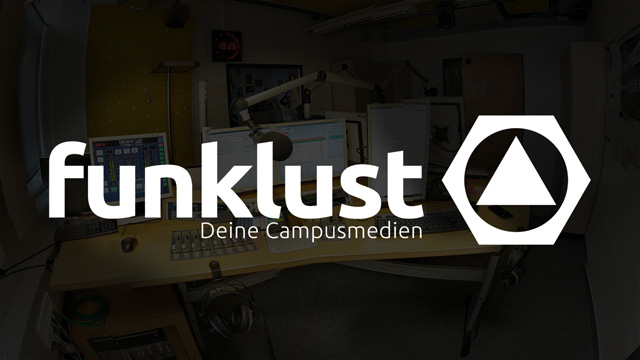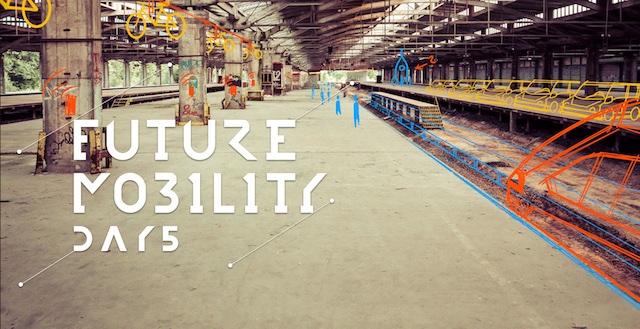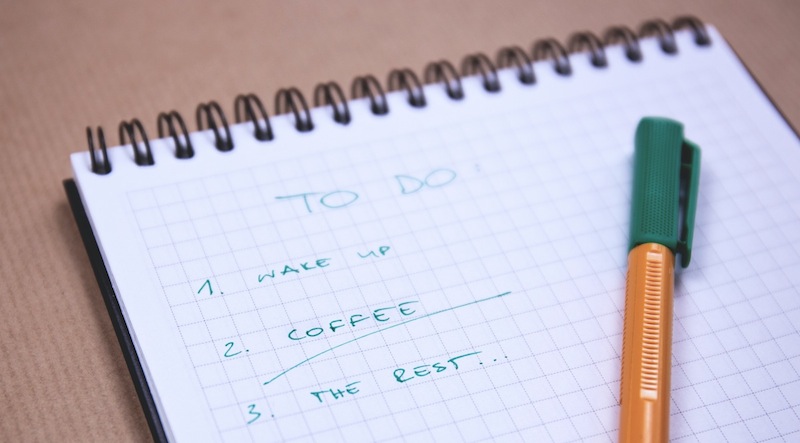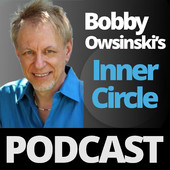-

I just finished a project I’ve been working on lately. I created jingles and show themes for the university radio station “funklust” in Erlangen, Germany.
Take a listen to the audio montage:
About the Station
funklust is a student initiative of the Friedrich-Alexander-Universität Erlangen-Nürnberg in Germany. The station name loosely translates to “the joy of broadcasting”. Their studio is located at the Fraunhofer Institute for Integrated Circuits IIS which at the same time is the transmission site.
The playlist mainly covers genres like indie rock, singer-songwriter and various mixtures of electronic rock and pop. The program gets distributed via a web stream, digital radio (DAB+) and DRM (100 Watt shortwave transmitter).
Start of the Project
All started with a rebrand of the station formerly known as “bit eXpress”, because another student initiative working with video joined them. So they had not only to search for a new name but also for a new station sound.
The new package includes
- Audio content for 4 programs (show openers, music beds, sweepers)
- General jingles and sweepers
- Information elements (news & weather)
- Top of the Hour jingles (daytime & nighttime)
- Promos for all programs
I did all the composition, production, mixing and mastering. The voiceover was recorded and delivered by the funklust team.
-

In February 2017 my employer organized the Future Mobility Days in the Museum for Communication Nuremberg. A two-day event in which over 300 participants took part to talk about digitalisation in the area of mobility. It followed three formats: a Barcamp for discussion, Design Thinking Jam, where small teams designed solutions using paper prototypes, and a Hackathon where the actual creation began.
For this exciting event we needed a countdown timer in the form of a twenty-second music track. While I was at it, I also created an audio logo and a 4-minute music track to accompany the videos that followed the event.
Take a look at a short recap:
-
Yesterday I listened to Boston’s “Third Stage”. An album that took six years to accomplish. Wow! A duration that seems totally insane from today’s perspective.
In the liner notes of the CD, producer and lead guitarist Tom Scholz states that he didn’t use orchestral sounds or synthesizers. Yes, that seems legitimate for a rock band in the 80s coming from the 70s era. But how did he create all these noisy/spacy sounds? Well…
No Synthesizers
That’s right! Honest! And no violins either (so how do you make thunderstorms without a synthesizer? A twenty-year old Vox Tone-Bender with a bad transistor). In other words, the Boston sound is powered by old, straight ahead rock-n-roll equipment, as opposed to midi-interconnected-computer-sequenced synthesizers.
Tom Scholz
-
Finally it’s done!
Today (October 24, 2016), Alex Perez’s first EP “Lilly” is released.
I mixed all tracks and did the arrangement, drum programming, production and engineering on the track “Not Myself”.
Check it out on Bandcamp: musicalexperez.bandcamp.com/album/lilly

-
When mixing music, it’s easy to get distracted. At the point you have a static mix, you probably start fixing something with an EQ, begin to fiddle around with effects, compressors and so on. It’s aimless and unfocused.
To overcome this dilemma I use a very simple but powerful tool. Pen and paper.
How should this help me mixing?
Well, you don’t go grocery shopping without a list and when you’re hungry. Otherwise you come back with all sorts of things, but surely forgot the milk you actually wanted to buy.

How does it work?
- Listen to the whole song, but don’t touch anything in your DAW.
- Write down the things that bother you in the mix (e.g. harsh vocals).
- Then implement everything on your list.
- Repeat this process until the mix is finished.
Like using a shopping list you simply check off every item until you’re done. This greatly increased my focus and confidence while mixing a track.
You could probably also do this with your favorite text processor on the computer. But at least for me pen and paper keep me away from the mouse and keyboard, force me to listen to the music and focus on the really important stuff instead of doing little moves which in the end probably won’t make a difference for the listener.
So next time you’re mixing give it a try and let me know if it worked out.
-
I recently recorded some mid tempo catchy pop rock song with a singer/guitar player. In these sessions I learned some things I wanted to share with you.
Arrangement/Instrumentation
Before I even started recording, I checked that the arrangement workes out. A good arrangement can make or break a song. In this particular case it was a song with the same chord progression repeated over the verse and chorus. To add a bit of variety we changed the instrumentation in the verse and chorus part of the song and the way it was played on the guitar. Sometimes I added some keyboard parts underneath, just to create a little uplifting feeling.
A shaker and tambourine added some excitement as well. They’re barely audible, but if you mute them, you would notice it immediately. The trick here is to not having too much instruments playing at the same time.Session duration
Sessions won’t get any better if they last longer. Recording basic vocals and overdubs in short sessions (~3 hours) is definitely practicable when everything is well prepared (lyrics, arrangement, …).
For instrument recording this may be different. Vocal sessions tended to be more exhausting. Both for the singer and me, the engineer. Ask your artist how he/she wants to handle it.Keeping the focus
I created a list of the things I wanted to record and prioritized it. Important stuff was on the top of the list. This helped me to keep the focus and not forget anything to be recorded. Great background vocals won’t do you any favor if you haven’t recorded the lead vocals yet.
-
My picture of a stereotypical teenager is the following: Riding on public transport with earbuds, listening to music. But: Do they listen consciously?
By “listening consciously” I mean following speech (e.g., podcasts) or music actively, not only to fill the void.Some do this to get some sleep on a trip, canceling out the noise with more pleasant noise – you may call it music. For others it’s probably some kind of barrier to the outside world while being in public.
If there’s a germ of truth, does this only apply to teenagers? Certainly not! It seems to be present in every segment of society. Don’t get me wrong! I’m not against listening to music in the background and for fun. It just seems people start to lose the ability to listen consciously.
We are losing our hearing
Many people take refuge in headphones, but they turn big, public spaces like this, shared soundscapes, into millions of tiny, little personal sound bubbles. In this scenario, nobody’s listening to anybody.
Julian Treasure – TED Talk – 5 ways to listen better
In his TED talk “5 ways to listen better”, Sound consultant Julian Treasure asks us to pay attention to the sounds surrounding us. That’s true, but when it comes to music I furthermore listen in a different way.
I want to consume music in good quality. Either music that is recorded very well or driving me emotionally. Which doesn’t mean a song with a harsh sounding guitar solo is a bad thing, when it can evoke a good feeling.
This is totally subjective. On the technical side things are different.
-
For me it’s always important to get inspired and stay curious. Beside crawling blogs and subscribing to YouTube channels I found a different way to absorb all sorts of information about sound related stuff: Podcasts!
They give a good overview of topics in a short amount of time and let you be part of interesting discussions. I was surprised at how well most of them are produced and how many valuable information its creators share with their audience over this channel.
Today I have put together a short list of podcasts worth listening to. For those of you who are new to some of them I also recommend two episodes for an easy start.1. Everything Sounds
Definitely the most interesting podcast if you’re not too much into technical stuff, but more into sound in art, science and culture, and our everyday lives.
Recommended episodes:
Episode 45: Sounds of Skateboarding
Episode 55: Restaurant Sound Design2. tonebenders
As the name implies, a podcast about sound design and field recording. Hosted by René Coronado, an audio post professional working in Dallas, Dustin Camilleri, a sound designer, re-recording mixer and composer from Chicago and Timothy Muirhead, a sound editor from Toronto. All I can say about it: Great tips, great interviews with a deep insight into the world of professional audio and nice hosts who will even answer listener questions.
Recommended episodes:
Episode 16: Gordon Hempton
Episode 18: Vanessa Ament on Foley3. Bobby Owsinski’s Inner Circle
In each episode Bobby starts with a quick roundup of the last week’s industry news, gives you helpful tips and interviews prominent people in the industry. You should also check out his music production blog.
Recommended episodes:
Episode 6: Writing Jingles with David Campos
Episode 14: Mike Rodriguez Discusses Mixing Commercials and Television -
You know, when you’re sick you take all sorts of medicine. Some taste bad, some make sparkling sounds if you put them into water. And that’s exactly what I did, but not without recording it.
Finally I opened the file in Apple Logic, applied some EQ and processed it through effects and automated effect loops. This is what the result looks and sounds like…
Make sure you watch it in high definition, since Vimeo’s audio codec removes most of the high frequency content.


